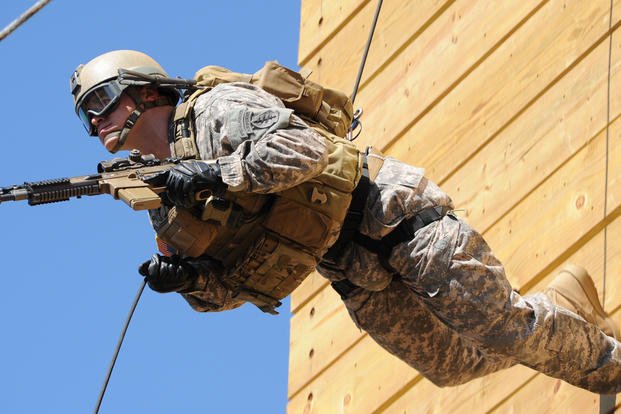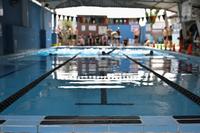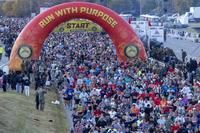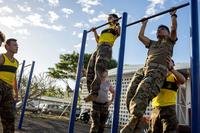A well-trained special operator is at the core of all successful missions in all branches of service. Becoming a special operator requires a rigorous screening process. However, each branch of service has its own preparation courses to give applicants who apply themselves a better chance of succeeding. Special ops attrition rates are above 50%-75%, and that takes its toll -- not only fiscally, but on the lives of those who train to become a special ops team member.
Here is an overview of the different preparation courses offered:
Special Operations Preparation Course (SOPC): This two-week primer course is designed to prepare the Special Forces candidates for what is typically the hardest phase physically -- Special Forces Assessment and Selection (SFAS).
However, for members of the National Guard (REP 63) and 18x newly enlisted members, there is another prep course:
Army Special Forces Preparation and Conditioning (SFPC): This is nearly three weeks long and will take the new soldier or National Guard SF candidates to a new level of fitness and land navigation. After these prep courses, soldiers will attend the SFAS course and the follow-on Special Forces Qualification Course.
Army Special Forces Assessment and Selection: The Army has been creating Special Forces operators longer than any of the branches have been around and uses the Army training pipeline to their advantage to prepare those interested in Special Forces (Green Berets). This is the high attrition section the Army candidates have to endure in order to attend the SF Qualification Course (45 weeks).
Navy SEAL and SWCC Prep Course, BUD/S and SWCC training: In the Navy, there is no natural war-fighter pipeline for SEALs to follow, so the Navy relies heavily on recruitment and the pre-BUD/S phases to prepare their candidates. In the last decade, the pre-SEAL/SWCC programming has grown not only to a six- to eight-week prep course in Great Lakes, Illinois (after boot camp), but also recruiting teams with mentors in each recruiting district. The recruiters and mentors work together to get candidates to score competitively on the Navy BUD/S and SWCC physical screening test (PST). Once they reach competitive standards, they ship to boot camp and then do the prep course called -- pre-BUD/S. Here they will run, PT, lift, swim, swim with fins, do pool drills (tread, knot-tying, lifesaving, drown-proofing) and other skills in the water coached by SEALs and contracted coaches.
RECON Marine screener: Every month in Camp Lejeune, N.C., and Camp Pendleton, California, Marines who wish to join the reconnaissance community are given the opportunity to take the RECON screening test (500-meter swim in cammies, USMC PFT, obstacle course, brick swim, gear retrievals, ruck and other events). The Marine Force and Division Reconnaissance conduct their own selection process from one another.
However, the Basic RECON Primer Course (BRPC) is a five-week course designed to prepare and select marines who are physically ready to attend and pass the basic reconnaissance course (BRC). BRPC focuses on swimming skills and pool drills, which requires mental strength. On land, physical fitness continues with running, rucking, PT, logs, obstacle courses and more. All students regardless of rank must attend and complete BRPC before attending BRC.
Marine MARSOC prep course/selection screener: The Marine Raiders also have a "preparation phase" to their assessment and selection. It is called phase 1. In the Assessment and Selection Phase I Course (ASPOC), all Marines must attend the three-week Assessment and Selection Phase I Course at Camp Lejeune. Phase I is a comprehensive prep program that is physical in nature but with an emphasis on nutrition, combat fitness and resiliency. Attendance at A&S Phase I does not guarantee a seat at selection phase 2.
If the Marine is capable of scoring 225 (but you should max) on the PFT; perform a variety of water skills, such as swim and tread in uniform (no boots), and drown-proofing; ruck 12 miles in three hours or less; and have competitive grades from classroom and physical events, they can pass phase 1. After the first phase, students may get invited to attend a more secretive A&S Phase II, which is a more physically, tactically and mentally challenging course and conducted at an undisclosed location.
Air Force Battlefield Airman Prep Course/PJ, CCT, TACP, SOWT Selection Courses -- Air Force Battlefield Airmen Prep Course -- I recently met with the course designers and operators who stated they started a new military command with the mission to prepare Air Force Special Ops candidates better. Col. Ronald Stenger is spearheading a highly technical training program using sophisticated monitoring gear (Smartabase) to improve training, reduce injuries and create more Air Force PJs, combat controllers, tactical air control party/JTAC and special ops weather technicians with fewer applicants. They successfully have taken all the ideas of the above prep courses within SOCOM and developed a technologically advanced platform.
The goal is to reduce the 80% attrition rate by being smarter and more efficient. The new eight-week prep course is conducted after basic military training for all Air Force battlefield airmen candidates before their follow-on selection courses.
Stew Smith is a former Navy SEAL and fitness author certified as a Strength and Conditioning Specialist (CSCS) with the National Strength and Conditioning Association. Visit his Fitness eBook store if you're looking to start a workout program to create a healthy lifestyle. Send your fitness questions to stew@stewsmith.com.
Want to Learn More About Military Life?
Whether you're thinking of joining the military, looking for fitness and basic training tips, or keeping up with military life and benefits, Military.com has you covered. Subscribe to Military.com to have military news, updates and resources delivered directly to your inbox.



















